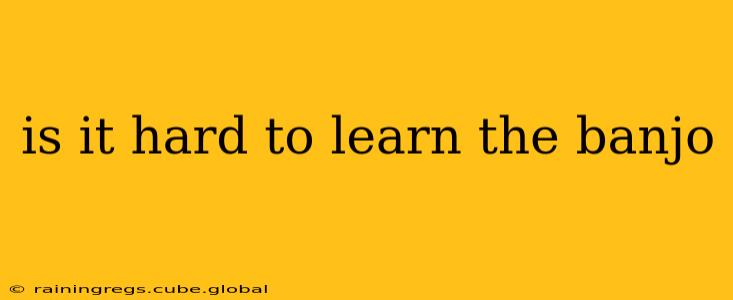Is It Hard to Learn the Banjo? A Comprehensive Guide
The question, "Is it hard to learn the banjo?" doesn't have a simple yes or no answer. The difficulty depends on several factors, including your musical background, learning style, dedication, and desired skill level. While some find it relatively straightforward, others encounter significant challenges. Let's delve into the specifics.
What Makes Learning the Banjo Challenging?
Several aspects of the banjo can present hurdles for beginners:
-
Unique Tuning: The banjo's tuning (often gDGBD or open G) differs from many other instruments, requiring adjustment to finger placement and chord formations. This is a significant hurdle for those transitioning from guitar or other instruments.
-
Three-Finger Style: Mastering the three-finger picking style (also known as Scruggs style) requires significant dexterity and coordination. It's a complex technique demanding precise timing and finger independence. While other styles exist, Scruggs is frequently associated with the instrument and is often a goal for many learners.
-
High String Tension: Banjo strings are typically under high tension, making them more challenging to fret cleanly than those on some other stringed instruments. This can lead to hand fatigue, especially in the early stages of learning.
-
Finding a Good Teacher or Resources: While many online resources exist, finding a qualified banjo teacher can significantly aid progress. Good instruction provides personalized feedback and addresses individual challenges.
What Makes Learning the Banjo Easier?
Conversely, some aspects can make banjo learning more accessible:
-
Simple Chord Structures (in some styles): While Scruggs style emphasizes complex picking patterns, other banjo styles utilize simpler chord progressions, making them easier to grasp for beginners.
-
Abundant Learning Resources: The internet offers a plethora of instructional videos, tutorials, and online courses catering to all levels, from absolute beginners to advanced players.
-
Rewarding Sounds: The unique sound of the banjo is inherently engaging, providing a strong incentive to persevere through the challenges of learning.
-
Focus on Specific Goals: Starting with simple songs and focusing on achievable goals can improve motivation and make the learning process feel less overwhelming.
How Long Does It Take to Learn the Banjo?
The time it takes to learn the banjo varies drastically based on individual factors:
-
Daily Practice: Consistent practice is key. Even 15-30 minutes a day yields significant progress over time.
-
Learning Style: Some learners grasp concepts quicker than others.
-
Goals: Learning a few simple songs takes less time than mastering complex Scruggs style picking.
-
Natural Aptitude: Some individuals have a natural predisposition for music and acquire skills more rapidly.
A reasonable expectation is to play simple songs and chords within a few months of dedicated practice. Mastering complex techniques like Scruggs style picking might take years of consistent effort.
What are the Different Banjo Styles?
There are several distinct banjo playing styles, each with its own level of difficulty:
-
Scruggs Style: Known for its fast-paced, complex picking patterns, this is often considered the most challenging style.
-
Clawhammer Style: A less technically demanding style employing a simpler, percussive picking technique.
-
Bluegrass Style: Often incorporates elements of Scruggs style and emphasizes rhythmic precision.
-
Frailing Style: A rhythmic and percussive style characterized by a single-finger picking technique.
Choosing a style that aligns with your learning goals and preferences greatly influences the perceived difficulty.
Can I Teach Myself to Play the Banjo?
Yes, it's entirely possible to teach yourself the banjo. Many online resources and instructional books can guide you through the process. However, consider the benefits of a qualified teacher for personalized feedback and structured learning. A good teacher can also help identify and correct bad habits that can hinder your progress.
In conclusion, the difficulty of learning the banjo is subjective and depends on individual circumstances. While challenges exist, the rewarding musical journey makes the effort worthwhile for many. Start with achievable goals, practice consistently, and most importantly, enjoy the process!
